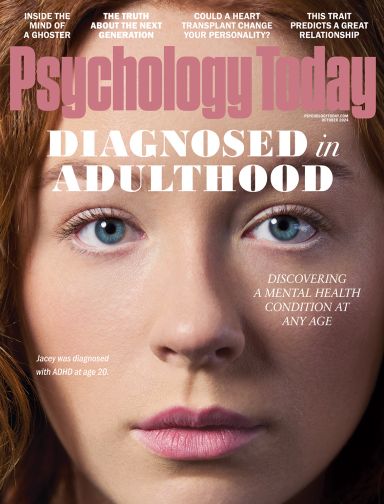

For Mother’s Day this blog will not address the pressing issues of psychiatry today. Suffice it to say that the harm done by the twin traumas of deprivation and abuse generate all the psychiatric struggles we are all subject to. This is the other side of the story - in appreciation for what I have learned about love from my wife.
In the beginning we are a zygote floating free in a fallopian sea; we are surrounded and held deep inside of Mother; she breathes for us – the breath of life comes from her lungs; likewise we exhale placentally back through her; she eats for us with predigested food; our waste products similarly take their leave back into mother; we are safe inside her shock absorber womb; she is our eyes and ears – if she stumbles upon a lion, she runs away and we go with her. In this safe harbor we do our assigned job – we begin as a one celled organism, and in nine short months we grow and morph into a newborn baby. One day as an embryo we had no heart. Then it appeared and it was beating. In utero, Mother’s provisions are autonomic. It all happens automatically. In our first nine months of life our limbic system knows and records a maternal environment that is one of seamless and perfect responsiveness. From our immersion in this world, all of our experiences are mapped by our limbic system. Oxytocin and vasopressin are secreted from our hypothalamus, generating a feeling of love, tenderness, and warmth. Our autonomic nervous system created this state in the context of reading safety, trust, and responsiveness. There is no history of any limbic alarms generated by trauma.
Responsiveness is the essential element of loving. At birth things change. This is our first encounter with trauma. We get crushed passing through the birth canal, the very bones of our head remain unfused and malleable so they can take the journey without breaking. The moment is at hand… the top of a head surfaces… then the head, with a face that no one had ever seen before… shoulders emerge… and we slither out, a glistening umbilical cord trailing behind… the cord was cut. With no oxygen, it is breathe or die… There is quiet in the delivery room, as everyone holds their own breath, waiting… We cry…we breath… Everybody breathes… There is laughter in the delivery room. For our entire life our breathing had been placental-umbilical. We shift to our newly operational diaphragm/lung system, and it works.
The very design of our infant face is contoured for breast-feeding, having morphed into its breast-suckling design—a squished-in chin and flattened nose. Mother’s uterus starts to bleed. She puts us to her breast where we began to suckle. This triggers Mother’s pituitary to secrete oxytocin into her bloodstream. The oxytocin tightens up the smooth muscle of her uterus, which squeezes and closes off the ruptured blood vessels in the organ we had just vacated. Our first feeding stops Mother’s bleeding. It helps restore her intactness, and saves her life.
Birth itself had cast us in an unfamiliar state of major trauma, as well as life-or-death distress. Our limbic system records this new and untoward experience. Our hypothalamus was stimulated to start the fight/flight response, secreting corticotrophin-releasing hormone and stimulating the sympathetic nervous system. Our autonomic nervous system, through the vagus nerve, stimulated an increased heart rate. In concert with other brain nuclei, it stimulated the adrenals to secrete cortisol. This went back to the hippocampus and amygdala, the feeling centers. Our fight-or-flight response, with all its necessary aggression, followed. These reactions were regulated by neurotransmitters, particularly serotonin.
But Mother restores us back to wholeness. She holds us in her warm and tender arms, and brings us to her breast. We are held once again in a new way. We are quieted and soothed. Our intactness is restored. The holding and warmth previously supplied by the womb is re-established. The continuity of holding is unbroken. The oxytocin that our suckling stimulated not only let down Mother’s milk, and stopped her uterine bleeding, it would play one more important role in the relationship between ourselves and Mother. It also acted on her brain, where it stimulated the feelings of maternal love and tenderness itself. Our own suckling amplified the tender love we received. The oxytocin did its job. The Mother-baby attachment was intact.
From now on things are different. Our new environment is no longer autonomic and automatic. In this new world mini-disruptions are built in. If we are startled by a loud noise, our arms and legs will flail. Our heart pumps adrenaline, and we cry. This startle maps the fight-or-flight limbic response in our cortex. We are restored by Mother’s holding. Her responsive repair re-establishes, maintains, and maps our well-being through oxytocin once again. There is no such thing as perfect loving. There can only be good enough loving. And there only needs to be good enough loving. When we emerge from the womb we have spent our entire lives in a state of responsiveness. We are born into a state of trust. Trust is not learned. It has always been there. Our experience of distrust is learned. Our mapping of fight-or-flight will then include the restoration of limbic safety, warmth and tenderness. This is good enough mothering.
One day when we are six weeks old, Mother reaches down into the cradle and picks us up to feed us. Something stirred in her chest. All of a sudden she was bursting with a feeling of tenderness and love. She looked at us and we were looking at her. Something was different. She actually felt a feeling emanating from us. It touched her. It was the feeling of our being.
During those six short weeks, our foundational appetites and rudimentary emotions had morphed a sufficiently high level of order to crystallize into a feeling of tenderness and sweetness—the cohered feeling of our being. Yesterday there was no feeling emanating from us. And suddenly it was here. Yesterday, we were simply an infant. Today, we are a human being. I refer to this being, this feeling of us, as the Authentic Being. One day we had no Authentic Being, and then it was there, feeling.
A reader might say, “Six weeks? That sounds kind of arbitrary. What’s so special about six weeks?” Simply put, six weeks is when it happens. The feeling of our being at that point is an actual presence. Prior to that, when Mother held us in her arms, she did not actually feel anything from us. And then it happened. She was touched in feeling by our presence. This is the litmus test. We are present as a feeling being. Mother had been predisposed to love us at our birth, and she did. But now, with the presence of the feeling, she fell in love with us. This feeling of tenderness and sweetness touches her, and her Authentic Being and its feeling, touches us. We resonated in feeling. Prior to this, mutual feeling was not possible.
And so it began. Our consciousness is born. Our Authentic Being is a persona in our rudimentary theater of consciousness. The Authentic Being was purely the feeling of our being. It had no reference to an image of us at all. It has no representational form. It is not knowable through the senses, thinking, or image-ination. It could not be seen. It was not an idea. It did not lend itself to being understood or comprehended. It would only touch and be touched by feeling.
Our Authentic Being is a persona in our rudimentary theater. And it didn’t exist on its own. It arose in relation to an additional persona the Loving Other. The mappings of Mother’s responsive care in the womb, as well as her responsiveness during the first six weeks consolidated into the feeling of a second persona in our theater. Likewise, the Loving Other was purely a feeling of a being and had no representational form. Eddie’s theater coalesced, with these two feelings of beings resonating together with loving feeling - our oxytocic loving with mother’s oxytocic loving. This is the fulfillment of maternal love.
As we have seen, Mother’s nurture up to this point was sufficiently holding and responsive. Neither abuse nor deprivation had come into play significantly. Keep in mind that this extraordinary creation by our limbic cortex is just ordinary biology. It isn’t unique to humans. You may notice its presence in kittens, puppies, and fawns. Our human-being life began with our birth in the theater of consciousness. We inhabit our limbic-cortical theater and live through its synthetic illusions for the rest of our life. Our Authentic Being is our essential being and will remain so, inviolable, from now on. Likewise, it would be the basis of love, given and received for the rest of our life.
Prior to consciousness, physical touch had been the exclusive avenue of holding between ourself and Mother. With the beginning of consciousness, the resonant feelings of tenderness became the avenue of connection between them. This is the realm of feeling. The feeling of our Authentic Being supplants and was the extension of physical touch and holding. The very words that characterize feeling are lifted from the words for physical sensations. You physically touch me. Your feeling touches me. Physical warmth is comfort. Emotional warmth is comfort. Sweetness is the taste of mother’s milk. Sweetness is the feeling of attachment. Tender is a soft and delicate texture. Tender is a soft and delicate feeling. Physical softness is gentle to the touch. Feeling is softness itself.
When new and higher levels of cortical order supplant older forms of order, the earlier forms of established brain-body mappings remain intact and operative. Physical touch and its brain circuits are ongoing and retain enormous power. The body-brain mappings of physical touch remain present and operative throughout life. Touch generates powerful feelings in people of all ages and is an important component of intimacy and closeness. This can be emotionally confusing later in life, when physical touch without relationship love can easily be confused with loving. And even more important, sexuality, which is inherently connected to physical touch, can also be confused with loving closeness. In the absence of real intimacy, it is not love and can be misleading. Actual love is the feeling resonance between two Authentic Beings.
The source of all loving is maternal love. Maternal love is the emotional environment through which we grow and prosper and thrive. As we mature we carry the maternal love inside of us in our theater of consciousness. If we peer into a time-lapse camera we will see our morphogenesis take us from the womb to mother’s holding arms, from her holding arms to off by ourself. We rolled over. We sat. We crawled. We walked. We walked away, following our curiosity. We turned back to see mother watching us. We saw that she was. We were carried in her holding gaze. We went off again, out of sight. We no longer needed to check in on her gaze. It was inside of us. We carried her, carrying us in her gaze. We carried her in our heart. She is still there.
At every step of our growth, Mother holds us once again in a new and differentiated way. Each boundary shift is accompanied by the pain of loss. She went from a full womb to an empty womb; from an empty womb to holding arms; from holding arms to empty arms; from empty arms to holding us in her gaze; to being out of sight, to being held in her heart. We are still there.
Mature love is the intimacy between two adults. In essence each one gives good enough maternal love to the Authentic Being of each other. They resonate together with their Authentic Beings.
Robert A. Berezin is the author of “Psychotherapy of Character, the Play of Consciousness in the Theater of the Brain”



